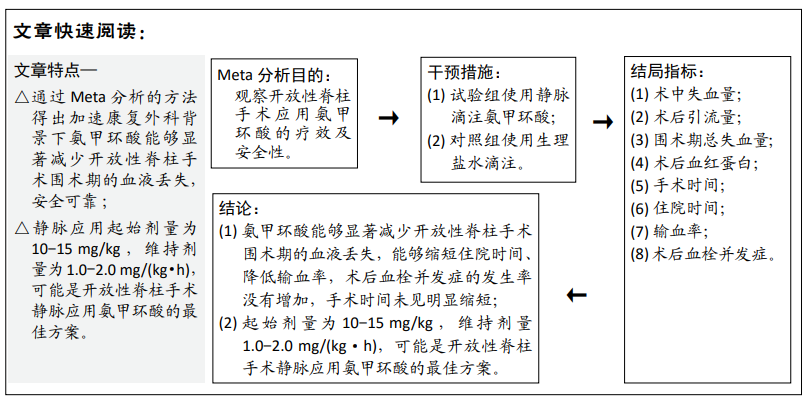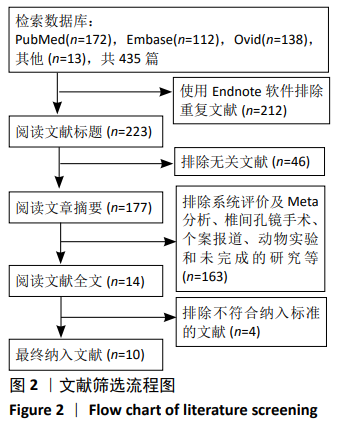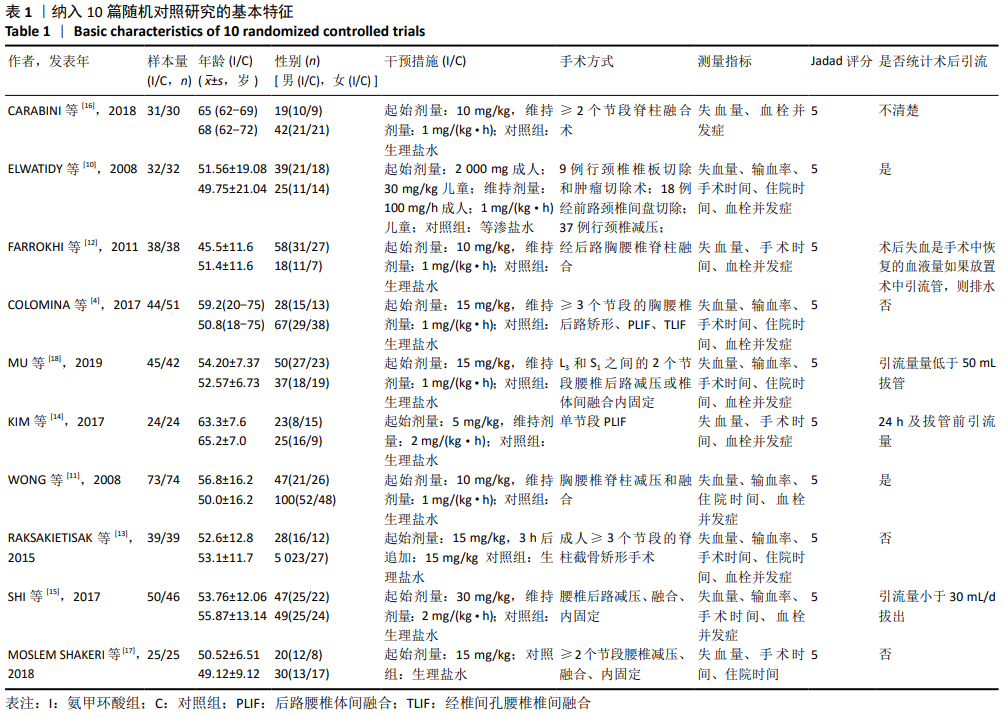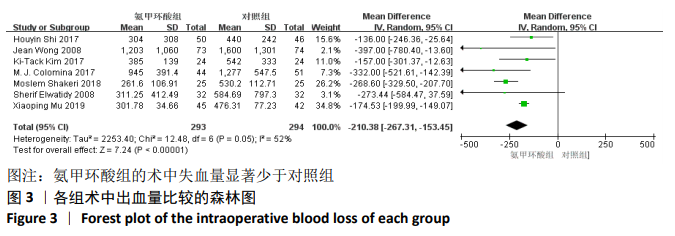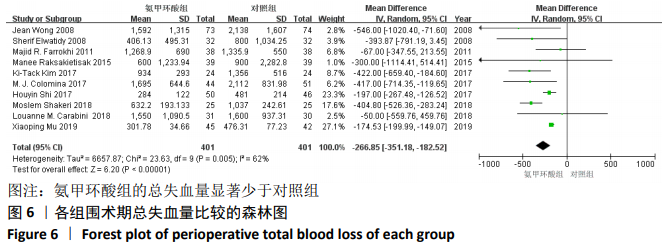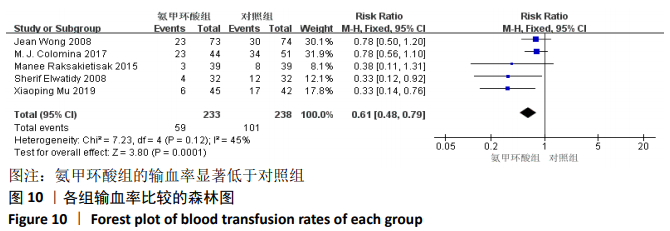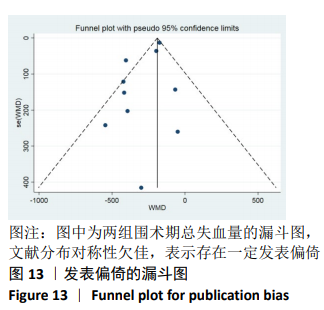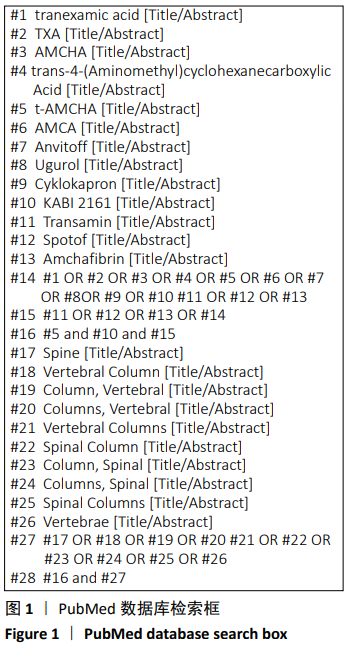[1] 裴福兴.加速康复外科是现代骨外科发展的趋势[J].中国骨与关节杂志,2017, 6(12):881-882.
[2] 孙天胜,沈建雄,刘忠军,等.中国脊柱手术加速康复—围术期管理策略专家共识[J].中华骨与关节外科杂志,2017, 10(4):271-279.
[3] 周宗科,翁习生,孙天胜,等.中国骨科手术加速康复—围术期血液管理专家共识[J].中华骨与关节外科杂志,2017, 10(1):1-7.
[4] COLOMINA MJ, KOO M, BASORA M, et al. Intraoperative tranexamic acid use in major spine surgery in adults: a multicentre, randomized, placebo-controlled trialdagger. Br J Anaesth. 2017;118(3):380-390.
[5] 中国康复技术转化及发展促进会,中国研究型医院学会关节外科学专业委员会,中国医疗保健国际交流促进会关节疾病防治分会,等.中国骨科手术加速康复围手术期氨甲环酸与抗凝血药应用的专家共识[J].中华骨与关节外科杂志,2019, 12(2):81-88.
[6] 翟荣华,佘勇军,屈文平.脊柱外科术中和术后应用氨甲环酸的临床效果[J].临床骨科杂志,2019,22(5):546-549.
[7] LIU JM, PENG HM, SHEN JX, et al. A meta-analysis of the effectiveness and safety of using tranexamic acid in spine surgery. Zhonghua Wai Ke Za Zhi. 2010;48(12): 937-942.
[8] 谭响,匡荣彬,谢继勇,等.氨甲环酸对脊柱手术围术期作用的系统评价和Meta分析[J].中华创伤杂志,2017,33(9): 785-791.
[9] 郑菡,彭霁,任运钦,等.局部应用氨甲环酸对脊柱手术患者凝血及纤溶功能的影响[J].解放军医学杂志,2019,44(5): 405-411.
[10] ELWATIDY S, JAMJOOM Z, ELGAMAL E, et al. Efficacy and safety of prophylactic large dose of tranexamic acid in spine surgery: a prospective, randomized, double-blind, placebo-controlled study. Spine (Phila Pa 1976). 2008;33(24):2577-2580.
[11] WONG J, EL BH, RAMPERSAUD YR, et al. Tranexamic Acid reduces perioperative blood loss in adult patients having spinal fusion surgery. Anesth Analg. 2008;107(5): 1479-1486.
[12] FARROKHI MR, KAZEMI AP, EFTEKHARIAN HR, et al. Efficacy of prophylactic low dose of tranexamic acid in spinal fixation surgery: a randomized clinical trial. J Neurosurg Anesthesiol. 2011;23(4):290-296.
[13] RAKSAKIETISAK M, SATHITKARNMANEE B, SRISAEN P, et al. Two doses of tranexamic acid reduce blood transfusion in complex spine surgery: a prospective randomized study. Spine (Phila Pa 1976). 2015;40(24): E1257-E1263.
[14] KIM KT, KIM CK, KIM YC, et al. The effectiveness of low-dose and high-dose tranexamic acid in posterior lumbar interbody fusion: a double-blinded, placebo-controlled randomized study. Eur Spine J. 2017;26(11):2851-2857.
[15] SHI H, OU Y, JIANG D, et al. Tranexamic acid reduces perioperative blood loss of posterior lumbar surgery for stenosis or spondylolisthesis: a randomized trial. Medicine (Baltimore). 2017;96(1):e5718.
[16] CARABINI LM, MORELAND NC, VEALEY RJ, et al. A randomized controlled trial of low-dose tranexamic acid versus placebo to reduce red blood cell transfusion during complex multilevel spine fusion surgery. World Neurosurg. 2018;110:e572-e579.
[17] SHAKERI M, SALEHPOUR F, SHOKOUHI G, et al. Minimal dose of tranexamic acid is effective in reducing blood loss in complex spine surgeries: a randomized double-blind placebo controlled study. Asian Spine J. 2018;12(3):484-489.
[18] MU X, WEI J, WANG C, et al. Intravenous administration of tranexamic acid significantly reduces visible and hidden blood loss compared with its topical administration for double-segment posterior lumbar interbody fusion: a single-center, placebo-controlled, randomized trial. World Neurosurg. 2019;122:e821-e827.
[19] CHERIYAN T, MAIER SN, BIANCO K, et al. Efficacy of tranexamic acid on surgical bleeding in spine surgery: a meta-analysis. Spine J. 2015;15(4):752-761.
[20] 俞慧强,郑辉烈,李悦,等.Meta分析发表偏倚诊断方法研究[J].中国卫生统计, 2011,28(4):402-405.
[21] 时亮,段亮,董向辉.大剂量氨甲环酸用于脊柱矫形及长节段固定手术的安全性和有效性分析[J].河北医学,2018, 24(10):1715-1719.
[22] WINTER SF, SANTAGUIDA C, WONG J, et al. Systemic and topical use of tranexamic acid in spinal surgery: a systematic review. Global Spine J. 2016;6(3):284-295.
[23] 朱前拯,于彩霞,陈星佐,等.氨甲环酸对人工关节置换术治疗老年股骨颈骨折围手术期失血的影响[J].中华创伤骨科杂志,2018,20(7):623-626.
[24] 石志刚,韩兵,付宇,等.氨甲环酸局部应用和静脉注射对全膝关节置换有效和安全性的Meta分析[J].中国组织工程研究,2018(11):1798-1804.
[25] BIBLE JE, MIRZA M, KNAUB MA. Blood-loss Management in Spine Surgery. J Am Acad Orthop Surg. 2018;26(2):35-44.
[26] 杨明坤,李舟,何坤林,等.氨甲环酸在老年腰椎椎管狭窄症患者围手术期血液管理中的作用[J].脊柱外科杂志,2019, 17(4):235-239.
[27] 罗兴鹏,解京明,王迎松,等.氨甲环酸在脊柱外科患者围手术期中的应用研究进展[J].山东医药,2020,60(11):87-90.
[28] 王峰,王静成,南利平,等. 氨甲环酸应用于腰椎后路椎间融合术的安全性和有效性[J].中国脊柱脊髓杂志,2019,29(5): 422-430.
[29] CRAVENS GT, BROWN MJ, BROWN DR, et al. Antifibrinolytic therapy use to mitigate blood loss during staged complex major spine surgery: Postoperative visual color changes after tranexamic acid administration. Anesthesiology. 2006;105(6):1274-1276.
[30] 顾力军,张洪美,张斌,等.脊柱手术发生氨甲环酸相关型癫痫1例[J].中国骨伤, 2018,31(3):276-278. |
